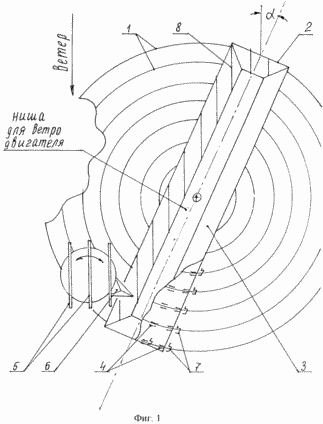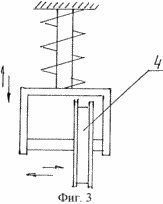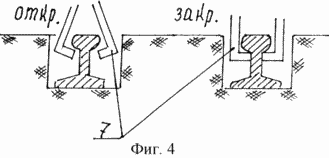| Start of section
Production, amateur Radio amateurs Aircraft model, rocket-model Useful, entertaining |
Stealth Master
Electronics Physics Technologies Inventions |
Secrets of the cosmos
Secrets of the Earth Secrets of the Ocean Tricks Map of section |
|
| Use of the site materials is allowed subject to the link (for websites - hyperlinks) | |||
Navigation: => |
Home / Patent catalog / Catalog section / Back / |
|
INVENTION
Patent of the Russian Federation RU2242636
![]()
STRAIGHT-STABILIZING DEVICE FOR WIND-MOTOR
The name of the inventor: Kolesnikov E.Yu. (RU); Kolesnikov Yu.V.
The name of the patent holder: Mari State Technical University
Address for correspondence: 424024, Yoshkar-Ola, pl. Lenina, 3, MarSTU, Department of Intellectual Property
Date of commencement of the patent: 2003.04.16
The invention relates to the field of wind energy, namely to the device of a rotating wind turbine system. The technical result consists in the creation of a device that allows to mount and operate in terrestrial conditions powerful large-sized wind turbines with a uniformly distributed mass of the structure mounted on the platform. The pivot-stabilizing device contains circular paths, a central support and a supporting platform with wheels at the ends. Circular rail tracks are located concentrically and evenly over the entire area, at the bottom of the platform, evenly spaced support rollers are fixed, the attachment points of which are projected onto the rails, the supporting rollers of the outer rows have locking hooks, the device is additionally equipped with a multi-roller stabilizer mounted on an independent platform with the ability to move On circular paths and attached to the platform rigid coupling.
DESCRIPTION OF THE INVENTION
The invention relates to the field of wind energy, namely to the device of a rotating wind turbine system.
A rotary-stabilizing device for a windmill is known, comprising circular paths, a central support, a supporting platform with wheels at the ends (see, for example, SU, 1523710 A1, class F 03 D 5/02, 23.11.1989, Fig. 1, 2 ), On a set of essential characteristics taken for the closest analog (prototype) of the invention.
The drawbacks of the prototype include inadequate reliability of operation of the device and bulkiness of the structure.
The technical result, consisting in the creation of a device that allows mounting and operation in terrestrial conditions, powerful large-sized wind turbines with a uniformly distributed mass of the structure, mounted on the platform, is provided by the fact that in the rotary-stabilizing device for the windmill, containing circular paths, the central support, A support platform with wheels at the ends according to the invention, the circular rail tracks are arranged concentrically and evenly over the entire area, from below the platforms are fixed uniformly located support rollers, the attachment points of which are projected onto the rails, the supporting rollers of the outer rows have locking hooks, the device is additionally provided Multi-keystail stabilizer mounted on an independent platform with the ability to move around circular paths and attached to the platform rigid coupling. The circular paths are flush with the ground surface. Support rollers are located at the bottom of the platform with an interval of 7-15 m. The multi-keel stabilizer is located at the end and on the side of the turntable and operates in unperturbed airflow, away from the working zone of the windmill. The angle between the longitudinal axis of the platform and the direction of the wind is 20-45 °. The bonnet cowl on the windward side has air flow guides in the form of oblique ridges.
 |

|
 | |
 |
FIG. 1 shows a rotationally-stabilizing device for a wind turbine (general view); FIG. 2 shows an element of a platform-shaped structure with support rollers; FIG. FIG. 3 shows a support roller having two degrees of freedom; FIG. FIG. 4 shows a locking hook. |
The rotary-stabilizing device for the wind turbine consists of a system of ground concentric rail tracks 1, a rotating platform of the windmill 2, covered by a cowling-fairing 3, support rollers 4, a multi-keystar stabilizer 5, a rigid coupling 6, hooks 7 fixing the ridges 8.
The principle of the device. At calmness the system is in an arbitrary position. When the wind appears, stabilizer 5 rolls on its rollers along rails 1, dragging the tail part of platform 2 behind it due to coupling 6 and both become "downwind". Thus, the rotary platform 2 is installed by the head end to the wind, forming an angle " ![]() "Between the longitudinal axis of the platform 2 and the direction of the wind of 20-45 °, while the guide combs 8 keep the wind flow from slipping to the side (in" bypassing the installation "), and the cowling-fairing 3 raises it upwards, into the blade working area, Providing the best operating conditions for the wind turbine.
"Between the longitudinal axis of the platform 2 and the direction of the wind of 20-45 °, while the guide combs 8 keep the wind flow from slipping to the side (in" bypassing the installation "), and the cowling-fairing 3 raises it upwards, into the blade working area, Providing the best operating conditions for the wind turbine.
To change the angle of installation of the platform 2 to the wind, it is sufficient to turn the stabilizer 5 around its axis to the calculated angle, while the stabilizer 5, trying to rise again in the wind, shifts the platform 2 by a given angle. When the wind force reaches a certain limiting value, the locking hooks 7 act on the rollers, preventing the platform 2 from disrupting the tracks 1.
CLAIM
1. Rotary-stabilizing device for a wind turbine (hereinafter referred to as a turning device), containing circular paths, a central support, a supporting platform with wheels at the ends, characterized in that the circular railways are located concentrically and evenly over the whole area, Rollers, the attachment points of which are projected onto the rails, with the support rollers of the outer rows having locking hooks, the device is additionally equipped with a multi-keel stabilizer mounted on an independent platform with the ability to move along circular paths and attached to the platform by a rigid coupling.
The rotary device according to claim 1, characterized in that the circular paths are flush with the ground surface.
3. The rotary device according to claim 1, characterized in that the support rollers are located at the bottom of the platform at an interval of 7-15 m.
4. The rotary device of claim 1, wherein the multi-keystail stabilizer is located at the end and side of the turntable and operates in an unperturbed airflow away from the windmill working zone.
5. The rotary device according to claim 1, characterized in that the angle between the longitudinal axis of the platform and the direction of the wind is 20-45 °.
6. The rotary device according to claim 1, characterized in that the cowl-fairing on the windward side has air flow guides in the form of oblique ridges.
print version
Publication date 31.01.2007gg




Comments
Commenting on, remember that the content and tone of your message can hurt the feelings of real people, show respect and tolerance to your interlocutors even if you do not share their opinion, your behavior in the conditions of freedom of expression and anonymity provided by the Internet, changes Not only virtual, but also the real world. All comments are hidden from the index, spam is controlled.